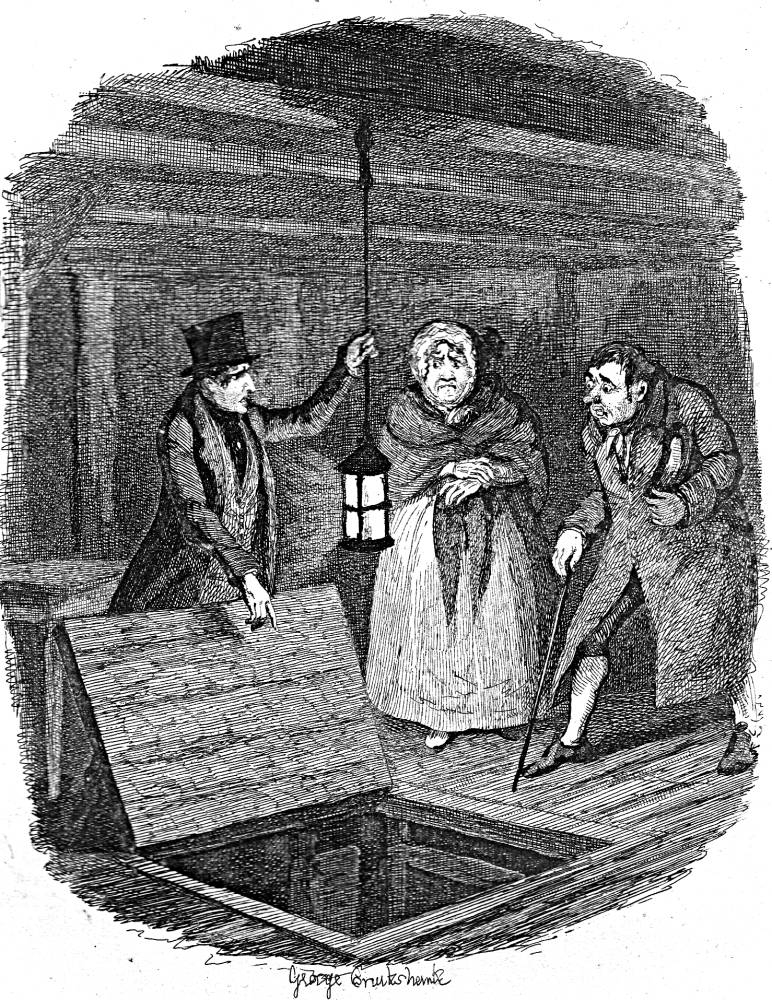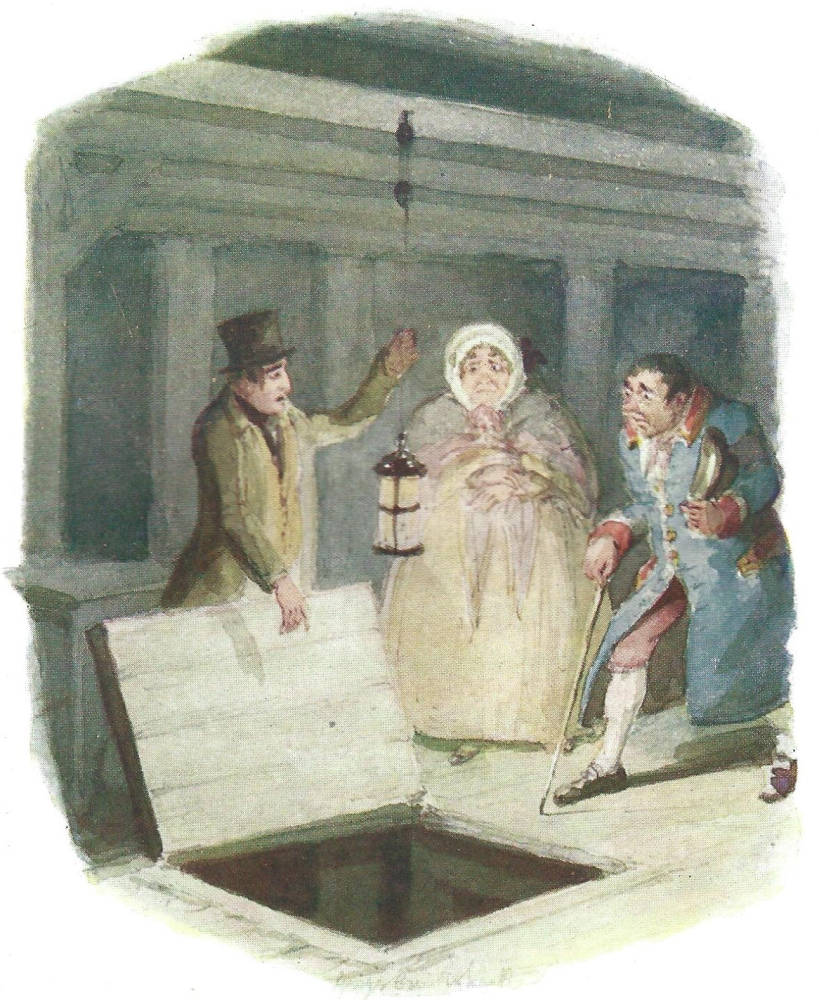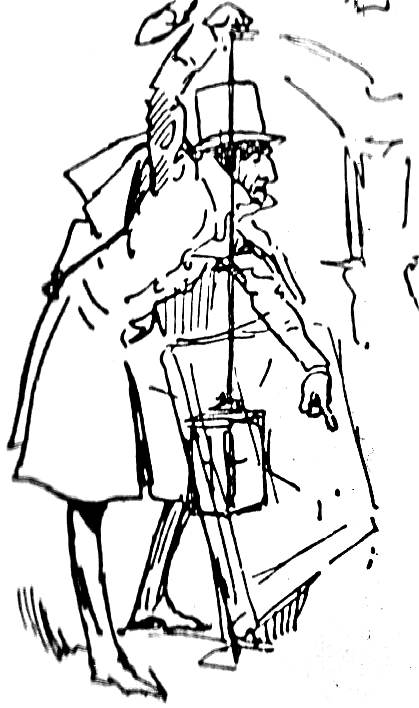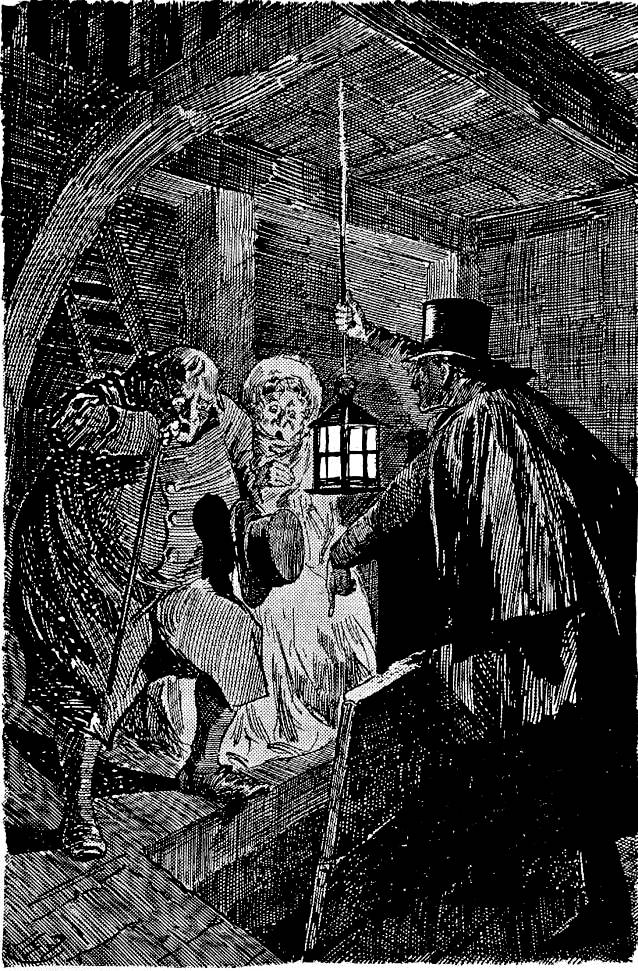

The evidence destroyed — seventeenth steel engraving and later watercolour for Charles Dickens's The Adventures of Oliver Twist; or, The Parish Boy's Progress, first published in volume by Richard Bentley after its August 1838 appearance in Bentley's Miscellany, Part 17, Chapter XXXVIII. 4 ½ by 3 ⅝ inches (11.6 cm by 9.3 cm), vignetted, facing page 213. Cruikshank's own 1866 watercolour, commissioned by F. W. Cosens, is the basis for the 1903 chromolithograph. [Click on the images to enlarge them.]
- Title-page and frontispiece
- George Cruikshank's coloured Illustrations from 1903 Collector's Edition of Oliver Twist
Passage Illustrated: Monk's tries to cancel Oliver's existence
With these words, he suddenly wheeled the table aside, and pulling an iron ring in the boarding, threw back a large trap-door which opened close at Mr. Bumble's feet, and caused that gentleman to retire several paces backward, with great precipitation.
"Look down," said Monks, lowering the lantern into the gulf. "Don't fear me. I could have let you down, quietly enough, when you were seated over it, if that had been my game."
Thus encouraged, the matron drew near to the brink; and even Mr. Bumble himself, impelled by curiousity, ventured to do the same. The turbid water, swollen by the heavy rain, was rushing rapidly on below; and all other sounds were lost in the noise of its plashing and eddying against the green and slimy piles. There had once been a water-mill beneath; the tide foaming and chafing round the few rotten stakes, and fragments of machinery that yet remained, seemed to dart onward, with a new impulse, when freed from the obstacles which had unavailingly attempted to stem its headlong course.
"If you flung a man's body down there, where would it be to-morrow morning?" said Monks, swinging the lantern to and fro in the dark well.
"Twelve miles down the river, and cut to pieces besides," replied Bumble, recoiling at the thought.
Monks drew the little packet from his breast, where he had hurriedly thrust it; and tying it to a leaden weight, which had formed a part of some pulley, and was lying on the floor, dropped it into the stream. It fell straight, and true as a die; clove the water with a scarcely audible splash; and was gone.[Chapter XXXVIII, "Containing an Account of what Passed between Mr. and Mrs. Bumble, and Mr. Monks, at their Nocturnal Interview," p. 213 in the 1846 edition]
Commentary: The Lost Heir Plot Thickens
Just as readers in the autumn of 1838 reached a crisis in the plot associated with obscure (and obscured) origins of Oliver — Monks's successfully locating and destroying evidence left by his mother, Agnes, at the workhouse — the rocky relationship between the up-and-coming writer and the veteran illustrator was reaching some sort of crisis, too:
Before the author left London [for a tour of Wales and the Midlands], he consulted with Cruikshank on the final chapters and suggested the last six topics [which is to say, plates 19 through 24, "The Jew and Morris. . ." to "Rose Maylie and Oliver"]. With Dickens gone, the artist executed the remaining plates [including "The Evidence Destroyed"] with varying degrees of indifference top the author's wishes. It made sense aesthetically to draw the lantern held by Monks in the process of destroying the evidence of Oliver's identity over rather than lowered into the well as described (XXXVIII, facing p. 288). . . . [Cohen, 21]
Thus, although the scene, likely nominated by the young author himself, does not correspond to the point about Monks's "lowering the lantern into the gulf" (213 in the 1846 edition), Cruikshank's solution to illuminate the scene in chiaroscuro by placing the lantern in the centre of the composition, dividing the sour-faced wife and apprehensive husband from the well-dressed but enigmatic Monks, strikes us as sensible; otherwise, with the lantern below floor level, the room would be in total darkness! However, Cruikshank's solution may not have been ratified by the absent Dickens, and so raises once again the issue of how far authorial authority has sanctioned the illustration. Dickens's description of the churning water at the bottom of the shaft is neither contradicted nor reinforced by the engraving, which Cruikshank has imbued with an appropriate and pervasive sense of mystery and even fatality.
The August 1838 illustration surely is the basis for the later interpretations of Mahoney and Furniss. While Eytinge's Monks lurks outside a lighted window, on a darkened stair — an interpretation that accords well with his clandestine and surreptitious nature, James Mahoney in the Household Edition volume's frontispiece has lowered and enlarged the lantern somewhat, thereby darkening the scene. Quite logically, Mahoney has depicted the aristocratic villain without his customary head-covering, which could quite easily be blown off his head and into the gulf (indeed, the illustrator has placed the hat on a table, right); a more realistic portrayal, perhaps, Mahoney's lacks the emotional intensity presented on the faces of Monks's co-conspirators in the Cruikshank original. Furniss's rendering of the scene heightens its drama by the sharpened contrast of the black-and-white shading, the terror on the faces of the Bumbles, and the emphatic gesture of Monks, whose facial expression the viewer cannot apprehend. That Furniss gave the figure of Monks holding the lantern a place of prominence (the lower left-hand corner) in Characters in the Story suggests that the later artist felt this was a pivotal moment in the narrative, even if he felt it necessary to depict Monks with his signature hat on in both the vignette and the full-page lithograph, which we encounter immediately after Dickens's economical but telling description in the text.
Illustrations from Three Other Editions (1867, 1871, and 1910)


Left: Sol Eytinge, Junior's Monks (1867). Right: James Mahoney's The Evidence Destroyed (1871). [Click on images to enlarge them.]


Left: Harry Furniss's thumbnail vignette of Monks with the lantern in Characters in the Story. Right: Furniss's Charles Dickens Library Edition illustration (1910) The Evidence Destroyed. [Click on images to enlarge them.]
Related Material
- Depictions of Bumble, the Parish Beadle from Oliver Twist and other Beadles
- Pailthorpe's Chromolithographs for Oliver Twist (1886)
- Oliver Twist as a Triple-Decker
- Oliver untainted by evil
- Like Martin Chuzzlewit, it agitates for social reform
Scanned images and text by Philip V. Allingham. [You may use these images without prior permission for any scholarly or educational purpose as long as you (1) credit the photographer and (2) link your document to this URL in a web document or cite the Victorian Web in a print one.]
Bibliography
Bentley, Nicolas, Michael Slater, and Nina Burgis. The Dickens Index. New York and Oxford: Oxford U. P., 1990.
Cohen, Jane Rabb. "George Cruikshank." Charles Dickens and His Original Illustrators. Columbus: Ohio State U. P., 1980. Pp. 15-38.
Darley, Felix Octavius Carr. Character Sketches from Dickens. Philadelphia: Porter and Coates, 1888.
Davis, Paul. Charles Dickens A to Z: The Essential Reference to His Life and Work. New York: Facts On File, 1998.
Dickens, Charles. Oliver Twist. Illustrated by George Cruikshank. London: Bradbury and Evans; Chapman and Hall, 1846.
_______. Oliver Twist. Works of Charles Dickens. Household Edition. 55 vols. Illustrated by F. O. C. Darley and John Gilbert. New York: Sheldon and Co., 1865.
_______. Oliver Twist. Works of Charles Dickens. Diamond Edition. 18 vols. Illustrated by Sol Eytinge, Jr. Boston: Ticknor and Fields, 1867. Vol. II.
_______. Oliver Twist. Works of Charles Dickens. Household Edition. 22 vols. Illustrated by James Mahoney. London: Chapman and Hall, 1871. Vol. II.
_______. Oliver Twist. Works of Charles Dickens. Charles Dickens Library Edition. 18 vols. Illustrated by Harry Furniss. London: Educational Book Company, 1910. Vol. III.
Forster, John. "Oliver Twist 1838." The Life of Charles Dickens. Ed. B. W. Matz. The Memorial Edition. 2 vols. Philadelphia: J. B. Lippincott, 1911. Vol. 1, book 2, chapter 3. Pp. 91-99.
Grego, Joseph (intro) and George Cruikshank."The evidence destroyed." Cruikshank's Water Colours. [27 Oliver Twist illustrations, including the wrapper and the 13-vignette title-page produced for F. W. Cosens; 20 plates for William Harrison Ainsworth's The Miser's Daughter: A Tale of the Year 1774; 20 plates plus the proofcover the work for W. H. Maxwell's History of the Irish Rebellion in 1798 and Emmett's Insurrection in 1803]. London: A. & C. Black, 1903. OT = pp. 1-106]. Page 66.
Kitton, Frederic G. "George Cruikshank." Dickens and His Illustrators: Cruikshank, Seymour, Buss, "Phiz," Cattermole, Leech, Doyle, Stanfield, Maclise, Tenniel, Frank Stone, Topham, Marcus Stone, and Luke Fildes. 1899. Rpt. Honolulu: U. Press of the Pacific, 2004. Pp. 1-28.
Created 22 April 2019 Last updated 14 January 2022